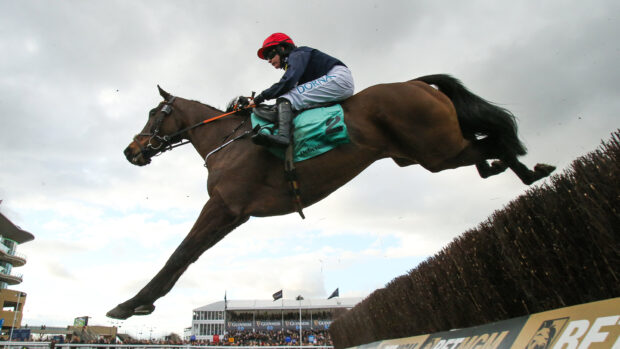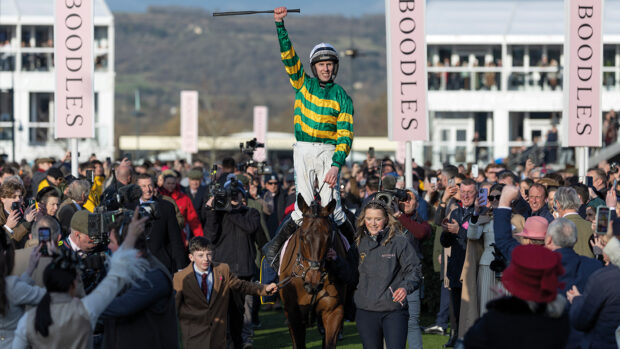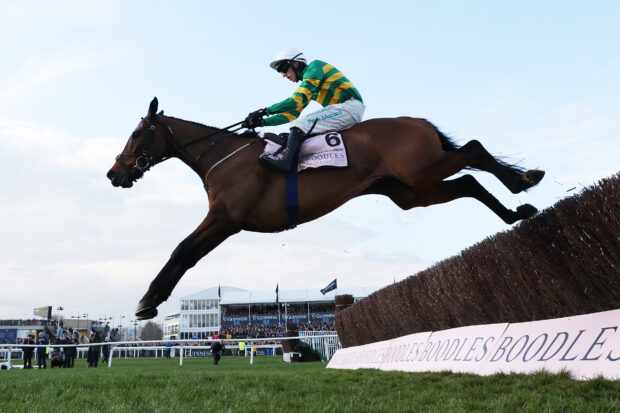As we build up to Cheltenham Festival week (11–14 March), we take a look back at the career of Istabraq, the treble Champion Hurdle winner with extraordinary jumping ability who was arguably robbed of an unrivalled fourth success.
What a totem he was. He’d shown some aptitude on the Flat, where he won twice from 11 starts, yet he underachieved for one of his breeding. He was, after all, a three-parts brother to Secreto, who’d won the 1984 Derby when trained within Ballydoyle by David O’Brien, son of Vincent.
It wasn’t long before Istabraq started to express himself on settling at Ballydoyle. He was ridden in all his 29 starts over hurdles by Charlie Swan. To this day, Swan remembers the hairs on his neck standing up when he schooled Istabraq for the first time.
“He saw the hurdles, pricked his ears and took them on,” Swan relates. “Jumping came naturally to him. You get a feeling from a young horse the odd time, but nothing like the feeling I got off Istabraq that morning.”
There was one caveat as Istabraq was being prepared for his hurdles debut at Punchestown in November 1996. He was prone to getting hot under the collar.
“Like a lot of good horses, he had nervous energy,” his trainer Aidan O’Brien says. “He was a free sweater and little things could upset him. It was all about keeping him relaxed. Temperament-wise, he was always ready to explode but that’s what made him so good. He was so naturally competitive, we had to be careful not to let that side of him come through when out at exercise.”
Although Istabraq was beaten narrowly on his hurdles debut, he showed such promise that he contested a Grade One race two weeks later. It was a sign of things to come – Istabraq raced prominently before sauntering away from his opponents at the third-last flight to win.
What’s more, he started a warm favourite, as he would in every race he contested thereafter. He’d win his next nine starts, the third of them at the 1997 Cheltenham Festival, where Istabraq’s legend began to take shape.
O’Brien saddled him for the Royal Sunalliance Novices’ Hurdle over an extended 2½ miles, rather than the Supreme over two.
“He’d won over two miles on the Flat,” he says. “With that type of horse, they tend to get further over hurdles. And we had another horse for the Supreme that year [Finnegan’s Hollow, who fell when leading at the third last].”
A similar fate nearly befell Istabraq. Having sat far back in the early stages, Swan had moved into contention when Istabraq was cannoned into as he rose at the second last.
“He got squeezed up and took a big bump,” O’Brien relates. “His blood was up after that; it made him fight harder.”
Istabraq recovered to lead over the last, after which he dug in to resist Mighty Moss’s late flurry by a length. Victory was all that mattered – Istabraq had been designated “banker” status by the tens of thousands of Irish racegoers who descend on the Cotswolds.
He’d won their hearts and filled their wallets, as he would do on three subsequent visits to the Festival, each time in the Champion Hurdle. And after that inaugural Festival triumph, Istabraq’s season would be geared entirely towards returning to Cheltenham in mint condition every March.

Trained by top Irish handler Aidan O’Brien, the gelding — who was bred to race on the Flat — won three consecutive Champion Hurdles in 1998, 1999 and 2000. Charlie Swan wore the famous JP McManus green and gold silks.
The gladiatorial slant to Irish runners at Cheltenham dates back to the early 1940s, when Arkle’s trainer, Tom Dreaper, annually carried Ireland’s pennant. Dreaper, who trained 26 Festival winners, was succeeded as Ireland’s totem by the aforementioned Vincent O’Brien, who saddled 23 Festival winners in 11 years from 1948.
The Irish hordes would back O’Brien blind. The consequence of a sub-standard Cheltenham Festival for him would punch a significant hole in Ireland’s national debt. He established Ballydoyle Stables, which became a source of pride to all Irishmen, and here was Aidan, his unrelated 28-year-old namesake with Istabraq under his wing. The symmetry was irresistible.
“I was young back then,” O’Brien recalls. “My wife [Annemarie] and I had not been long at Ballydoyle and I suppose Istabraq helped us to believe we could train a good horse. It was good for our confidence, but really, so many people at Ballydoyle were involved with the horse. Everybody played their part.”
None more so than Swan, who’d ridden some iconic Cheltenham Festival winners for Istabraq’s owner, JP McManus. A plethora of photographs and paintings of Istabraq pepper the walls of Swan’s house. He was champion jockey in Ireland nine times and rode some of the best jumpers in training, yet none left as lasting an impression on him as Istabraq.
“I used to see the horse [in retirement at JP McManus’ Martinstown Stud] as often as I could,” Swan says.
As for what set Istabraq apart, Swan is unequivocal.
“It was all about his jumping,” says the retired jockey. “When he was airborne, he’d get his back legs out very quickly. He was like a motorbike going over a ramp and landing on the back wheel. Istabraq’s hindlegs would often touch down first, before his forelegs.
“When that happened, he’d land running. Most horses land on their forelegs; they have to take that extra half-stride to get their hindlegs back underneath them. Whereas Istabraq, he’d be away from the hurdles in a flash. It made all the difference.”
That trait set Istabraq apart. Swan maintains the horse had more stamina than speed. Even though he had a high cruising speed, there were times when Swan had to prompt Istabraq to keep tabs on horses up ahead of him. He always knew the horse would respond and that he’d fight his corner every time. He also knew Istabraq would pinch a half-length at just about every hurdle he crossed.
Istabraq delivered his most visually arresting performance in winning his first Champion Hurdle in 1998, in which he beat his stablemate, Theatreworld. On that day, he raced prominently until a motionless Swan sent him for home three flights from the finish. From that point, the bay galloped further and further clear. Swan eased down well before the winning post, which the combination reached 12 lengths to the good.
It was a tour de force that set him up for an exemplary season in 1998–99, when he won all seven of his races. He started at 9/4 on to win his second Champion Hurdle, in which he again beat Theatreworld. From there he went to Aintree, where he toyed with French Holly. And he received a rapturous reception when he signed off at the Punchestown Festival by winning as he liked.
After that, a third Champion Hurdle triumph seemed something of a formality. That duly came to pass when he beat Hors La Loi III by four lengths. Istabraq was now an eight-year-old but there was no sign that time’s passage was blunting his sword.
A sudden end
He was the fifth horse to win the Champion Hurdle three times, yet none had completed the four-timer. History thus beckoned Istabraq’s tilt at the 2001 Champion Hurdle, for which he warmed up in customary style by winning the Irish equivalent at Leopardstown.
But the outbreak of foot-and-mouth led to the Cheltenham Festival’s abandonment.
“It was an absolute nightmare,” Swan recalls. “The horse was definitely robbed.”
Istabraq returned to Cheltenham one year later with a solitary seasonal outing under his belt. It wasn’t an ideal preparation, yet his status was such that he was again sent off favourite for the 2002 Champion Hurdle, which proved an extreme anti-climax.
Swan was obliged to pull him up after he’d jumped just two flights. It transpired Istabraq had damaged a tendon and was promptly retired. Even then, however, his fans rallied round to give him a royal send-off as he returned to be unsaddled at Cheltenham.
“The reception they gave him was unbelievable,” Swan relates. “It couldn’t have been any louder if he’d won the race. As it turned out, he was perfectly sound three months later. He could have run again, but the decision to retire him had already been made.”
Although there would be no glorious valediction, none was necessary. An indelible image of Istabraq is seared into Swan’s mind.
“It’s hard to believe over 20 years have passed,” he says. “It still seems like yesterday to me.”
O’Brien, for his part, is left with an abundance of memories. “The horse had an amazing following, a kind of following that was hard to believe,” O’Brien says. “JP McManus was conscious of that and very respectful of it.
“JP treated it as though the public actually owned the horse,” O’Brien continues. “After Cheltenham, we always tried to run him at Punchestown in April, which is not an easy thing, but JP wanted the public in Ireland to see as much of him as possible.
“The whole story was unbelievable really. Istabraq was a special horse, a different horse and everybody connected with him always came to watch him run. There was one big team behind him. And all the while he was here, we were always very conscious that we’d never see another one like him.”
“He was a very easy horse to ride,” says Charlie. “You could ride him any way you liked – from the front or in behind. He wasn’t the quickest horse in the world; he looked quicker than he actually was, but his brilliant jumping more than made up for it.
“He wasn’t over-big, just over 16hh, but he was strong, especially in his hindquarters. He would give a few bucks when you rode him in the mornings. You had to keep your wits about you but he was a happy horse. He gave us some brilliant days and great memories.”
Which moments filled Istabraq’s connections with the most pride?
“It has to be his first Champion Hurdle victory in 1998,” says his trainer, Aidan O’Brien. “He’d been working well in the build-up and JP [McManus, his owner] was convinced the two-mile trip was right for the horse. All we had seen from him made us hopeful, but in this game you’re never sure until they do it. I remember Charlie Swan riding him handy – he came off the bend strongly and galloped all the way up the hill.”
Swan adds: “His first Champion Hurdle win was great, but the third stands out for me. Very few horses win three of those, and I’m sure he’d have won a fourth but for the foot-and-mouth in 2001. There was pressure ahead of the race, which you feel in the build-up, but you’re fine once you jump aboard in the paddock. And I always rode better on a big day. Maybe I’m a show-off, but that’s how it was.”
Istabraq’s early years
Sometimes it is all about the horse, with a passing nod to trainer and jockey. But the tale of an equine legend is greatly enhanced when it extends to a human dimension. It can embrace romance, or triumph over adversity. In the case of Istabraq, it was all about poignancy.
Istabraq’s story was interwoven with the all-too-brief life of John Durkan, who bought the horse as a four-year-old out of John Gosden’s Newmarket stable, where he’d worked as Gosden’s assistant. It was 1996 and Durkan, who recognised Istabraq’s latent talent, had just taken out his own licence. Then he was diagnosed with leukaemia.
He underwent treatment as Istabraq’s new career over hurdles took flight under Aidan O’Brien, to whom he’d been entrusted in Durkan’s absence. Some 15 months after Durkan bought him, and with Istabraq an odds-on favourite to win the Irish Champion Hurdle, Durkan was laid to rest, aged just 31.
“They were very emotional days,” reflects O’Brien, whose Ballydoyle stable would evolve into a behemoth. “There was joy when the horse was winning big races, and at the same time great sadness over what was happening to John. John was involved in everything to do with Istabraq until he passed away.”
An old-school amateur who rode 93 winners under Rules, Durkan was universally popular. He’d spent eight years in Lambourn befriending the likes of Jamie Osborne, Ed Dunlop and Eddie Hales, all of whom would become trainers. Yet for all the grief at his cruel fate, there could be no more apposite beacon in Durkan’s memory than a horse like Istabraq.
Istabraq’s stellar career highlights
He won 23 of 29 starts over hurdles, including:
Champion Hurdle
1998, 1999, 2000
Irish Champion Hurdle
1998, 1999, 2000, 2001
December Festival Hurdle
1997, 1998, 1999, 2001
Hattons Grace Hurdle
1997, 1998
Aintree Hurdle
1999
Punchestown
Champion Hurdle
1999
Royal Sunalliance
Hurdle
1997
Istabraq’s key statistics
Bay gelding, foaled 23 May 1992, died 25 July 2024
By Sadler’s Wells out of Betty’s Secret, by Secretariat
Owner: JP McManus
Trainer: Aidan O’Brien
Breeder: Shadwell Estate Company Ltd
Jockey: Charlie Swan
A regally bred horse, Istabraq was a three-parts brother to Secreto, winner of the Derby in 1984. He was bred by the Shadwell Stud of Sheikh Hamdan Al Maktoum, who bought his dam, Betty’s Secret, in 1989. Betty’s Secret never ran; Secreto was her first foal and Istabraq her last. Despite visiting the courts of the world’s foremost sires, Betty’s Secret bred nothing else of any consequence. Istabraq was by Sadler’s Wells, who was champion Flat sire in Britain and Ireland 14 times.
- To stay up to date with all the breaking news from major shows throughout 2025, subscribe to the Horse & Hound website
You may also be interested in:

Farewell, Istabraq: tributes paid to legendary racehorse following his death aged 32

The Horse & Hound Podcast 162: multiple champion trainer Nicky Henderson

How to watch Cheltenham Festival 2025 live streams and TV coverage: your armchair viewing guide

Why hunting and fun rides are proving the perfect (if unusual) prep for this Cheltenham Gold Cup contender

Subscribe to Horse & Hound magazine today – and enjoy unlimited website access all year round




